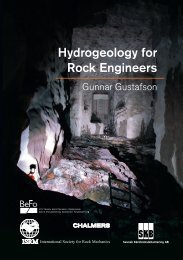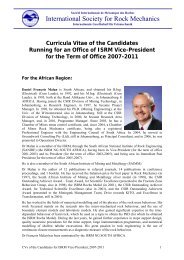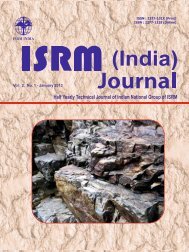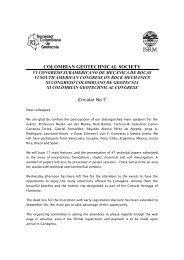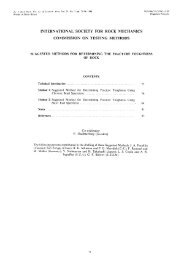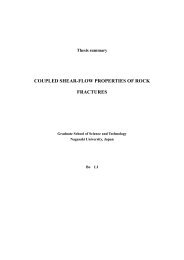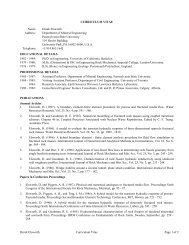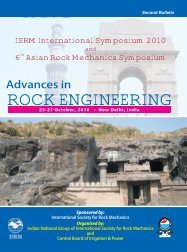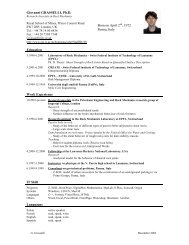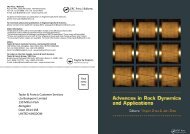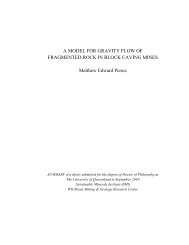ISSN : 2277-1328 (Online) - ISRM
ISSN : 2277-1328 (Online) - ISRM
ISSN : 2277-1328 (Online) - ISRM
You also want an ePaper? Increase the reach of your titles
YUMPU automatically turns print PDFs into web optimized ePapers that Google loves.
Study of Wellbore Stresses and Stability based on a Hollow Cylinder Model<br />
15<br />
the mud weight window is getting wider, so it is easier to<br />
avoid instability problems. Note that the minimum and<br />
maximum mud weights change only slightly and stay<br />
approximately constant when α is greater than a certain<br />
value, such as 3 or 4. This phenomenon can be used to<br />
predict the wellbore stability problems by virtue of hollow<br />
cylinder testing.<br />
Fig. 9 : The required mud weight without pore pressure<br />
4. CONCLUSIONS<br />
A hollow cylinder model was used in this paper to conduct<br />
the parametric analysis of wellbore stresses and stability<br />
in terms of three major parameters that have significant<br />
influence on the critical internal wellbore pressure, such<br />
as radius ratio α, pressure ratio β, and pore pressure P p<br />
.<br />
Different values of these parameters give rise to different<br />
stress distributions in the hollow cylinder and,<br />
subsequently, affect the critical internal pressures. In<br />
addition, the critical internal pressure also depends on<br />
the failure criterion and three popular failure criteria such<br />
as Mohr-Coulomb, Drucker-Prager, and the Modified Lade<br />
criterion have been considered in this paper. Several<br />
conclusions can be drawn from this work.<br />
Firstly, the radius ratios a has great impact on the minimum<br />
and maximum critical internal pressure. As this ratio<br />
increases, the minimum internal pressure decreases and<br />
the maximum internal pressure increases. In other words,<br />
the safe mud weight window will be widened if the radius<br />
radio increases. In addition, the minimum and the maximum<br />
mud weights change only slightly and remain approximately<br />
constant when a is greater than a certain value. This<br />
phenomenon can be used to scale the lab hollow cylinder<br />
test data up to the scale of wellbore stability problems. It<br />
also means that, from stress point of view, it is easier to<br />
control stability of an oilfield well than of a small hollow<br />
cylinder sample tested in laboratory environment.<br />
Secondly, pore pressure also plays an important role in<br />
borehole stability analysis and mud weight design. It can<br />
significantly weaken the rock by reducing confining stress,<br />
thus narrowing down the safe mud weight window to a<br />
great degree. When pore pressure effects and effective<br />
stresses are considered, the safe mud weight window is<br />
much narrower than when compared to the dry rock case.<br />
Hence, neglecting pore pressure (or inaccurate pore<br />
pressure estimation) will have misleading effect on safe<br />
mud weight choices and may result in triggering wellbore<br />
instability problems.<br />
Finally, this analysis confirms the differences and<br />
characteristics of the three yield criteria considered in this<br />
paper. The Mohr-Coulomb criterion is apparently<br />
conservative. It is a two-dimensional failure criterion that<br />
does not account for the intermediate principal stress<br />
strengthening effect. The Drucker-Prager criterion is<br />
apparently non-conservative and over predicts the s 2<br />
strengthening effect. The Modified Lade criterion is a<br />
moderate one, between the extremes of the other two criteria.<br />
Thus, it can provide reasonable mud weight predictions.<br />
Acknowlegdements : Support from the Petroleum<br />
Institute and local operating companies for the work<br />
covered in this paper is gratefully acknowledged.<br />
REFERENCES<br />
1. Jaeger J., Cook, N.G.W., and Zimmerman R. 2007, Fundamentals<br />
of rock mechanics, 4th edition, Blackwell Publishing.<br />
2. Santarelli F.J. and Brown E.T. 1989, Failure of three sedimentary<br />
rocks in triaxial and hollow cylinder compression tests. Int. J.<br />
Rock Mech. Min. Sci. Geomech. Abstr. 26 (5): 401-13.<br />
3. Chen X., Tan, C.P., and Haberfield C.M. 2000, Numerical<br />
evaluation of the deformation behaviour of thick-walled hollow<br />
cylinders of shale. Int. J. Rock Mech. Min. Sci. 37 (6): 947-961.<br />
4. Wang Y. and Wu B. 2001, Borehole collapse and sand production<br />
evaluation: experimental testing, analytical solutions and field<br />
implications. Proc. 38 th U.S. Symp. on Rock Mech., DC Rocks<br />
2001: Rock Mechanics in the National Interest, Washington DC,<br />
July 7-10, Elsworth, Tinucci and Heasley (eds).<br />
5. Marsden J.R., Dennis, J.W. and Wu B. 1996. Deformation and<br />
failure of thick-walled hollow cylinder of mudrock, a study of<br />
wellbore instability in weak rock. Proc. Eurock’96, Barla (ed).<br />
6. Biot M. A. 1941. General theory of three-dimensional consolidation.<br />
J. Appl. Phys. 12: 155-164.<br />
7. Kanj M. and Abousleiman Y. 2005. Fully-Coupled<br />
porothermoelastic analysis of anisotropic hollow cylinders with<br />
applications. Int. J. Num. Anal. Meth. Geom. 29 (2): 103-126.<br />
8. Zhou X. and Ghassemi A. 2009, Finite element analysis of coupled<br />
chemo-poro-thermo-mechanical effects around a wellbore in<br />
swelling shale. Int. J. Rock Mech. Min. Sci., 46 (4): 769-778.<br />
9. Lade P.V. and Duncan J.M. 1975. Elastoplastic stress-strain<br />
theory for soil. J. Geot. Eng. Div. ASCE, 101: 1037.<br />
10. Lade P.V. 1984. Failure criterion for frictional materials, Mechanics<br />
of Engineering Materials, Ch. 20, Desai and Gallagher (eds.),<br />
Wiley, 385-402.<br />
11. Ewy R.T. 1998. Wellbore stability predictions using a modified<br />
Lade criterion, Eurock 98, Trondheim.<br />
12. Colmenares L. B. and Zoback M. D. 2002. A statistical evaluation<br />
of intact rock failure criteria constrained by polyaxial test data for<br />
five different rocks, Int. J. Rock Mech. & Min. Sci., 39: 695-729.<br />
13. Hoskins E.R. 1969. The failure of thick-walled hollow cylinders of<br />
isotropic rock. Int. J. Rock Mech. & Min. Sci. 6: 99-125.<br />
14. Zhang L., Cao, P. and Radha K.C. 2010. Evaluation of rock<br />
strength criteria for wellbore stability analysis. Int. J. Rock Mech.<br />
Min. Sci. 47: 1304-1316.<br />
Volume 1 No. 2 July 2012




